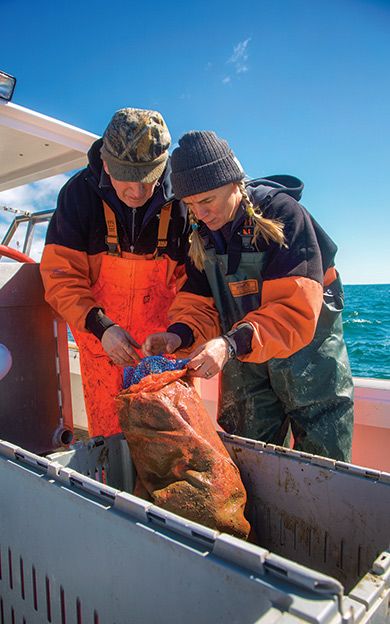Processing Your Payment
Please do not leave this page until complete. This can take a few moments.
- News
-
Editions
View Digital Editions
Biweekly Issues
- December 1, 2025
- Nov. 17, 2025
- November 03, 2025
- October 20, 2025
- October 6, 2025
- September 22, 2025
- + More
Special Editions
- Lists
- Viewpoints
-
Our Events
Event Info
Award Honorees
- Calendar
- Biz Marketplace
Diversification of Millers' Wharf breathes new life into Tenants Harbor
 Photo / David Clough
Merritt Carey, left, and Josh Miller, board members for the Tenants Harbor Fisherman's Co-op, are taking a new approach to fishing's supply chain.
Photo / David Clough
Merritt Carey, left, and Josh Miller, board members for the Tenants Harbor Fisherman's Co-op, are taking a new approach to fishing's supply chain.
 Photo / David Clough
Peter Miller, who is diversifying his fish business, checks his scallop spat bags that were set last fall in lower Penobscot Bay, with help from Merritt Carey. The baby scallops will be grown out by the aquaculture co-op in the lantern nets. Both Miller and Carey are on the board of the recently formed Maine Aquaculture Co-op.
Photo / David Clough
Peter Miller, who is diversifying his fish business, checks his scallop spat bags that were set last fall in lower Penobscot Bay, with help from Merritt Carey. The baby scallops will be grown out by the aquaculture co-op in the lantern nets. Both Miller and Carey are on the board of the recently formed Maine Aquaculture Co-op.
Family-owned Millers' Wharf thrived over the past 40 years, then encountered rough waters five years ago, so much so that the four brothers who own it considered selling it last year.
But big changes over the past year, including diversification with a new co-op and a Luke's restaurant, have the wharf in Tenants Harbor going full speed ahead.
“Any time you create diversification, in the town's and my mind, it's good, especially in the lobster business,” St. George and Port Clyde Harbormaster David Schmanska says. “I wouldn't be surprised if this could have a dramatic effect in garnering more fishermen in the next couple years.”
St. George comprises the villages of Port Clyde, Clark Island, Glenmere, Martinsville and Tenants Harbor. The total population is around 2,591, with about 1,850 of them in Tenants Harbor, according to U.S. Census data. Lower Penobscot Bay still is a hotbed for the lobster fishery on the peninsula and its islands.
Only five years ago, Millers' Wharf took a big hit, Schmanska says, when the Millers' paternal grandmother died and their Cod End Restaurant & Marina, which had supplied good food and talk along with diesel, ice and moorings to the yachting public and commercial fishermen for decades, closed.
“It changed from a vibrant business to a lobstering business,” Schmanska remembers.
But relying only on lobster was risky, says Josh Miller, a third-generation lobsterman, especially with warming waters and mismanagement of groundfish stocks depleting available species to fish.
Miller's father Peter and his three brothers still own the wharf under a company called A&R Enterprises. But a year ago they wanted to get out of the business, Miller says, and considered selling it.
Josh and other locals, including Merritt Carey, a lawyer turned entrepreneur who had summered in Tenants Harbor since she was a child, worried that if the dock were sold, there would not be local ownership and it would be out of the fisherman's hands, so the whole feel of the waterfront would change. The entire area of the wharf, restaurant, parking and a co-op building is a little under an acre.
Miller credits Carey and his uncle Hale with the dock's turnaround: it's now home to the 20-member Tenants Harbor Fisherman's Co-op, which leases the dock from A&R and is in negotiations to buy it. The co-op did so well in its first year, bringing in $4.2 million in revenue, that all the members got bonuses from the cash left after expenses. About 15 to 20 boats use the wharf, plus about 25 to 30 students, Miller says. Tenants Harbor has about 150 or so commercial fishermen, he says.
Additionally, in March 2016 Millers' Wharf closed on $250,000 in bond money from the Department of Marine Resources' Working Waterfront Access Program, with technical help from CEI, to preserve it as a working waterfront, with an easement owned by the state. A working waterfront designation includes a tax break.
And last summer it attracted Luke's first Maine restaurant location. Luke's processing plant, Cape Seafood, buys all of the lobster from the co-op, most of which goes to Luke's shacks, with some of it, such as the frozen tails, going to Hannaford and other retailers.
The most recent branching out is the new Maine Aquaculture Co-op formed under Maine's Fish Marketing Association law. It's located at Millers' Wharf and is the state's first aquaculture cooperative. Carey says the new co-op has $46,000 in funding from the Maine Department of Agriculture for development of an ear-hung scallop aquaculture infrastructure and buying lantern nets, plus a scallop grader and start wheel that can be transferred among different member vessels. The co-op matched the grant with $14,297.
It also received an $8,500 seed grant from the Maine Technology Institute this March to buy lantern nets, and the co-op matched that with $26,897.
Cutting out the middleman
Buying the wharf distinguishes the Tenants Harbor Fisherman's Co-op from others, says Luke Holden, a Cape Elizabeth native and owner of the Luke's Lobster chain of 30 restaurants and a member of the co-op's board, along with Miller and Carey. Luke's has restaurants in Boston, New York, New Jersey, Philadelphia, Washington, D.C. and Maryland, Miami, Chicago and Las Vegas, as well as Japan. The Tenants Harbor location is the only one in Maine, and likely will stay that way, he says.
“What's formed here is really special, and this restaurant is unique for us,” he says. “It's not every day that a fairly diverse group of people come together in a partnership based on trust and it works and continues to grow.”
He says the co-op gives both the old guard members and younger ones a chance to diversify their revenue stream. And being part of a co-op, they can get more for their catch than fishermen at neighboring wharfs, he says.
The pounds of lobster coming across the wharf almost doubled last year, he says. When co-op members buy a wharf, they can make even more money because they own the middleman — the wharf and its landlord — who typically would take 50 cents of the $4.50 price per pound of lobster.
Holden says Merritt initially came to him with the proposal to buy the wharf, but he said it didn't make financial sense to him at the time. “It's difficult to compete at a 50-cents margin,” he says. “We looked at the margins and realized we'd need more than 500,000 pounds of lobster to come across the wharf for it to be a standalone operation. They needed to get more fishermen and get their pounds up.”
That's where the idea of a co-op originated, he says. Carey says the co-op topped that poundage last year, so the members made money. The co-op now is paying to lease the wharf, and expects to take out a commercial loan to finance the purchase.
“We'll still lease it for a couple years so our operating costs will stay the same,” says Carey. But with his father and three uncles still owning landlord A&R, Miller says they are willing to keep the lease going for a while to help the co-op financially until it gets its mortgage.
“They'll know that even though the family doesn't own the wharf, it still will be owned by people who fish,” says Miller, including several other Millers who are co-op members.
Holden not only buys most of the lobster meat the co-op members catch, but gives 50% of the profits from the restaurant in Tenants Harbor back to the co-op. It's a small portion of the whole amount he buys for his restaurants around the country, he says.
Luke's at Tenants Harbor is open seasonally, and serves food that is traceable to a sustainable source. He says he may begin selling the aquaculture scallops being grown by some co-op members who want to diversify. Those scallops are grown using an ear-hung technique learned from an information exchange between Maine and Japanese fishermen. Holden says the Maine restaurant didn't make a profit its first year, which was a shortened season, but he expects it to this year.
Carey says she and Luke worked together to figure out how to get more money to the fisherman. That, in turn, could attract more of them to the co-op.
“So really, year one [of the co-op] was very successful,” says Carey. “All the fishermen were pleased with their dividend. But in terms of driving economic impact, it's going to be years two, three, four and five where we build off our success and really start to innovate through diversifying the products that come up over that wharf. That's where we should start to see expanded economic impact in the harbor.”
In 2015, the overall economic impact of commercial fishing businesses in St. George was 130 lobster fishing operators and 170 crew for 300 total employment, 28 commercial fishing wharfs, $30 million to $50 million for St. George fishermen and employees with a total impact of $100 million including regional multipliers, according to the St. George Business Alliance and Midcoast Maine Fishing Heritage Alliance.
That's not yet including the future impact of both the fisherman's and the aquaculture co-ops. Carey says their impact goes beyond just jobs. Last year the fisherman's co-op gave $500 to a program called boats for bikes that donates bikes to children who cannot afford them, lobsters to the Trekkers auction, lobsters to the St. George Community Sailing Foundation and lobsters for the crew who participated in a local island cleanup.
“We are by no means the only co-op making charitable donations, but it adds to the overall community economic impact picture,” Carey says. “I got involved in this because I knew enough about rural economic development to know the value of a family-owned and -operated wharf in a rural coastal town. I knew the wharf would return more to the community if it stayed locally owned. I knew there was a great 'trap-to-table,' family-run wharf story to be told.”
Mainebiz web partners

The Giving Guide
The Giving Guide helps nonprofits have the opportunity to showcase and differentiate their organizations so that businesses better understand how they can contribute to a nonprofit’s mission and work.
Learn More
Work for ME
Work for ME is a workforce development tool to help Maine’s employers target Maine’s emerging workforce. Work for ME highlights each industry, its impact on Maine’s economy, the jobs available to entry-level workers, the training and education needed to get a career started.
Learn More
Groundbreaking Maine
Whether you’re a developer, financer, architect, or industry enthusiast, Groundbreaking Maine is crafted to be your go-to source for valuable insights in Maine’s real estate and construction community.
Learn more-
The Giving Guide
The Giving Guide helps nonprofits have the opportunity to showcase and differentiate their organizations so that businesses better understand how they can contribute to a nonprofit’s mission and work.
-
Work for ME
Work for ME is a workforce development tool to help Maine’s employers target Maine’s emerging workforce. Work for ME highlights each industry, its impact on Maine’s economy, the jobs available to entry-level workers, the training and education needed to get a career started.
-
Groundbreaking Maine
Whether you’re a developer, financer, architect, or industry enthusiast, Groundbreaking Maine is crafted to be your go-to source for valuable insights in Maine’s real estate and construction community.
ABOUT
NEW ENGLAND BUSINESS MEDIA SITES
No articles left
Get access now
In order to use this feature, we need some information from you. You can also login or register for a free account.
By clicking submit you are agreeing to our cookie usage and Privacy Policy
Already have an account? Login
Already have an account? Login
Want to create an account? Register
Get access now
In order to use this feature, we need some information from you. You can also login or register for a free account.
By clicking submit you are agreeing to our cookie usage and Privacy Policy
Already have an account? Login
Already have an account? Login
Want to create an account? Register







Comments